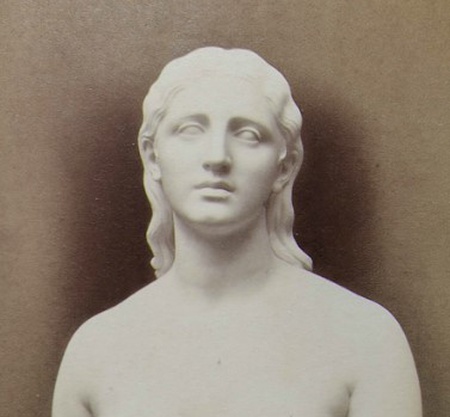Timken Museum of Art Presents "Modeling for the Masses: Sculptural Ideals in Nineteenth-Century America"
On View: October 23, 2024 - March 16, 2025
Featuring Works of the Acclaimed Sculptors of the Day
San Diego’s Timken Museum of Art will present Modeling for the Masses: Sculptural Ideals in Nineteenth-Century America October 23, 2024 through March 16, 2025. This new exhibition highlights the small-scale, three-dimensional works of acclaimed sculptors including celebrated works by Hiram Powers, Thomas Ball, Chauncey B. Ives and John Rogers.
Sculpture was remarkably popular during the period surrounding the American Civil War. Audiences flocked to exhibitions to see the latest works by favorite artists, many of whom established successful studios abroad during the Antebellum period. Sensing new demand for their art, many of these sculptors began making works for domestic spaces as well as the public sphere. To tell this story, Modeling for the Masses draws upon examples from the Timken’s permanent collection as well as significant loans from prominent public and private collections. Period photographs will show how works were often broadly disseminated, and both stereoviews and “cartes de visite” images represent another dimension of the exhibition.
Together, this presentation of two- and three-dimensional imagery signals how contemporary notions about media might be traced back to this earlier period. This is also reflected in the works by American artist Kehinde Wiley. Wiley is best known for his portraits that place young black men and women shown in traditional poses of Old Master paintings. Several works in this exhibition trace how Wiley’s sculpture engages current debates while deliberately referencing art ideals of the past.
"Today's museum audiences are unfamiliar with American sculpture of the mid-nineteenth-century," according to Derrick R. Cartwright, PhD, Director of Curatorial Affairs for the Timken Museum of Art. "Our eyes are all-too accustomed to flat screens and fast-moving images. The works in Modeling for the Masses require a more thoughtful observation and a different aesthetic tool kit. That said, there are important connections between our contemporary moment and the kinds of cultural debates that circulated around these influential works more than a century-and-a-half ago. I hope visitors to the exhibition will take pleasure in sensing both the differences and similarities that these works provoke."
Although sculptor Hiram Power is not as well-known today, he was one of the most successful artists of his time. He lived in Florence, Italy for most of his career but had profound impacts on American art practice and debates both before and after the Civil War. Powers’ Eve Disconsolate (c. 1870) was donated to the Timken last year and has not been on public view before. Thomas Ball, a close contemporary of Powers and an important public artist in his own right, is also represented at the Timken by his own depiction of Eve (1874). Ball’s focus on allegorical and biblical subject matter was typical of the first half of the 19th century.
Tabletop sculptures by John Rogers became immensely popular during the second half of the 19th century. Rogers made thousands of narrative compositions—which became known as “Rogers Groups”—in plaster selling them for about $15 each. Their mass reproduction meant they could be readily collected by middle class families who often placed them in prominent locations in homes as signifiers of their good taste. Coming to the Parson (1870), on loan from The San Diego Museum of Art, is a fine example of this kind of object.
Modeling for the Masses offers an opportunity to think about why these idealized subjects became so widespread and of interest to the broad public in post-Civil War United States. It will examine how monumental sculpture became part of American public consciousness and subsequently made its way into many American homes.
Sculptors working in the 19th century also took advantage of new technologies including photography, advertising in mass market magazines and other reproductive technologies to ensure that their works were seen by new audiences. Artists use different strategies today—social media, for example—but the roots of this self-promotional streak are evident in the objects gathered together by Modeling for the Masses. Timken visitors will be invited to experience stereographic views of sculpture and touch replicas of 19th-century sculpture as a part of the exhibition.

Chauncey B. Ives, "Bacchante," 1848, Marble, Collection of Irene and Kevin Rowe, Courtesy of Conner-Rosenkranz, NY; Photo by Mark Ostrander

Hiram Powers, "Eve Disconsolate," modeled 1855, this version c. 1870, Marble, Timken Museum of Art, San Diego, California

Thomas Ball, ‘Eve,’ 1874, Marble, Timken Museum of Art, San Diego, California; Photo by Brian Lockhart
# # #
"Modeling for the Masses: Sculptural Ideals in Nineteenth-Century America"
On View: October 23, 2024 - March 16, 2025
Monday, October 21, 2024 | 10 - 11am
Hosted by Derrick Cartwright, PhD., Timken Director of Curatorial Affairs
Featuring Guest Speaker Kevin Rowe - Lender to the Exhibition
Join us for a conversation and first look with Timken Director of Curatorial Affairs, Derrick Cartwright, Ph.D., and lender to the exhibition, Kevin Rowe, as they discuss Modeling for the Masses: Sculptural Ideals in Nineteenth-Century America, and sculpture collecting.
Tickets: Free for Members / $15 Non-Members
Learn More: https://www.timkenmuseum.org/calendar/event/curator-conversations-1/
Timken Museum of Art – Balboa Park
1500 El Prado
San Diego, CA 92101
619.239.5548
www.timkenmuseum.org
Museum Open: Wednesday-Sunday: 10am-5pm
Free admission, always.
# # #
